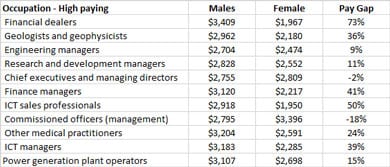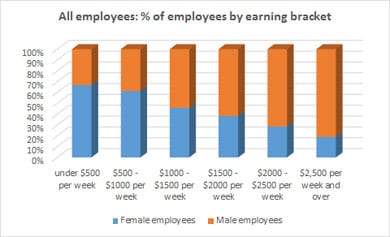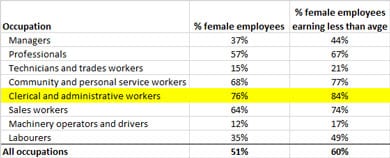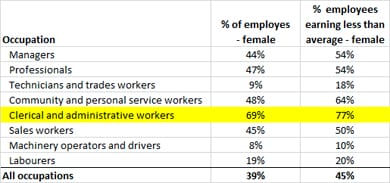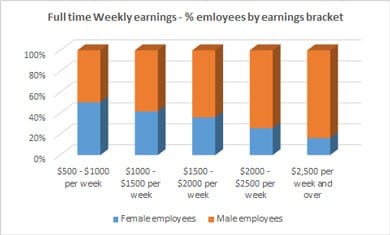The gender pay gap exists because, overall, men are paid more than women. This article looks specifically at the limited access women have to higher earnings, and how many women earn less than the average for their industry.
One of the many issues that contribute to the gender pay gap is the difference between the way traditionally female roles – caring professions – and male industries – everything else – are valued.
Engineers are paid a lot more than nurses, for instance, despite the fact that nursing can be dangerous, and is both physically and emotionally demanding. Registered nurses earn an average of $1220 a week, and electrical engineers $2019 per week. It’s also worth noting that even within those roles, a huge gender pay gap exists – 30% for nurses and 47% for electrical engineers.
The Australian Bureau of Statistics (ABS) Employee Earnings and Hours data demonstrate this pretty clearly. It is consistent and persistent across all industries. Even in the female dominated industries, male earnings far outstrip female earnings.
Some of the data needs to be treated with caution. For instance, the highest gender pay gap in the detailed list of 355 occupations, is ‘music professional’ at 257%, but there are so few females working as professional musicians that the average weekly earnings data has an error rate of over 50% and is therefore unrealiable.
So, looking only at the statistically reliable data, the average weekly cash earning for all employees in the top highest paying occupations, and their specific gender pay gap are:
The lowest paying occupations are:
The data is pretty clear that at both ends of the pay scale, women are losing out.
But this data alone doesn’t really describe the full picture of what’s happening. Without knowing how many people are being counted in each occupation, there is no way of knowing how much impact the average earnings impacts the overall gender pay gap. For instance, if there are 5000 male financial dealers and only one female, this is a much bigger problem for women than it is if those numbers were reversed.
Unfortunately, the nature of statistical data is that not all of it is available or reliable. The ABS does not provide the number of male and female employees in each occupation category.
There is however, an ABS dataset that shows the distribution of average earnings across gender and broad occupation. It counts the number of employees whose average weekly earnings are in a particular pay bracket, separated out into eight different occupations.
The graph below shows the gender breakdown in each earning bracket. So, females are 66% of the people who earn under $500 per week, and 18% of the people who earn more than $2500 per week.
While that is disturbing enough, it gets worse when you drill down into the details.
Of the eight occupation categories, three are very clearly female dominated:
I had to check the calculation in the highlighted line three times, because it just didn’t seem right. 76% of clerical workers are female, but 86% of them are paid less than the average weekly earnings for clerical workers? How is that even possible?
One of the biggest contributing factors is that so many women work part time. I’ve already written about the part time excuse being a furphy, but it might explain some of the discrepancy in this category. So I looked at the same data, filtered for just full time employees, paid at the adult rate. This is what I found:
Part time work is not a factor. Women are 69% of full time clerical workers, and 77% of those women are earning less than the industry average.
The gender splits in each pay bracket group for all full-time employees looks like this:
At the bottom end, where people are earning less than $1000 per week, the gender split is 50/50. At the top end, over $2500 per week, only 16% are women.
This pattern is repeated across all the occupations. Even full time professional women are experiencing significant barriers to the upper end of average weekly earnings. Again, it’s about 50/50 at the lower end, but only 22% of the people earning in the highest bracket are female.
Looking at the other occupation groups, and only at full time earnings, women in clerical and administration are 30% of the top earnings, sales is 28% and community services only 10%,
There are many factors that contribute to this. Obviously one is that women take time of out the workforce to have children, but that alone does not account for all the barriers to even achieving the industry average. Age, access to promotion, negotiation of salary, sub-concious bias and gendered expectations all play a part.
I’ll be looking at those factors in more detail over the next few weeks.
The Real Gender Pay Gap is a connecting series of articles on various aspects of the gendered barriers to achieving financial security.
Introduction – the gender pay gap series, what why and how
Part 1 – the real gender pay gap, it’s not 18%, it’s 52%
Part 2 – Part time work and the gender pay gap

